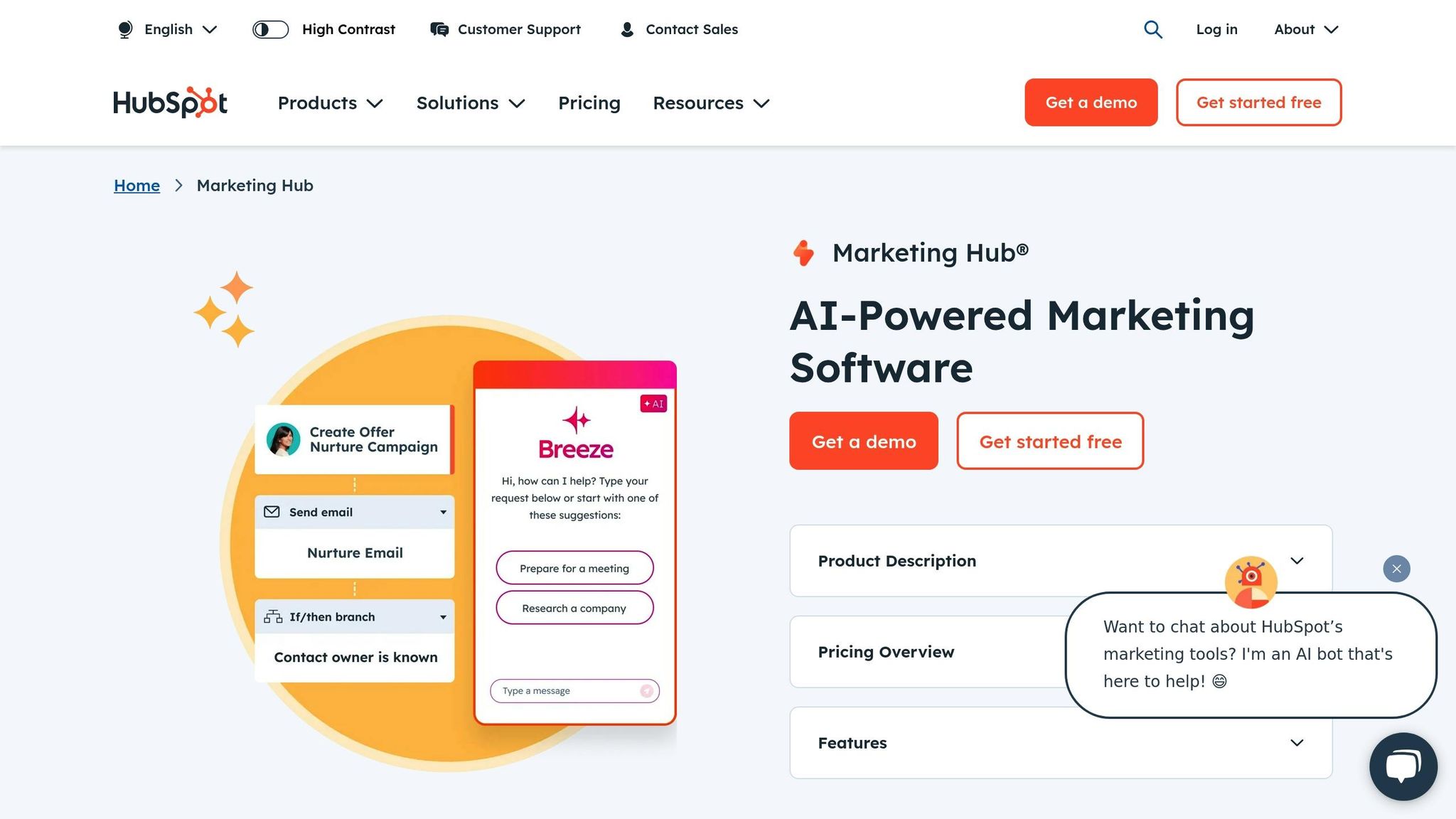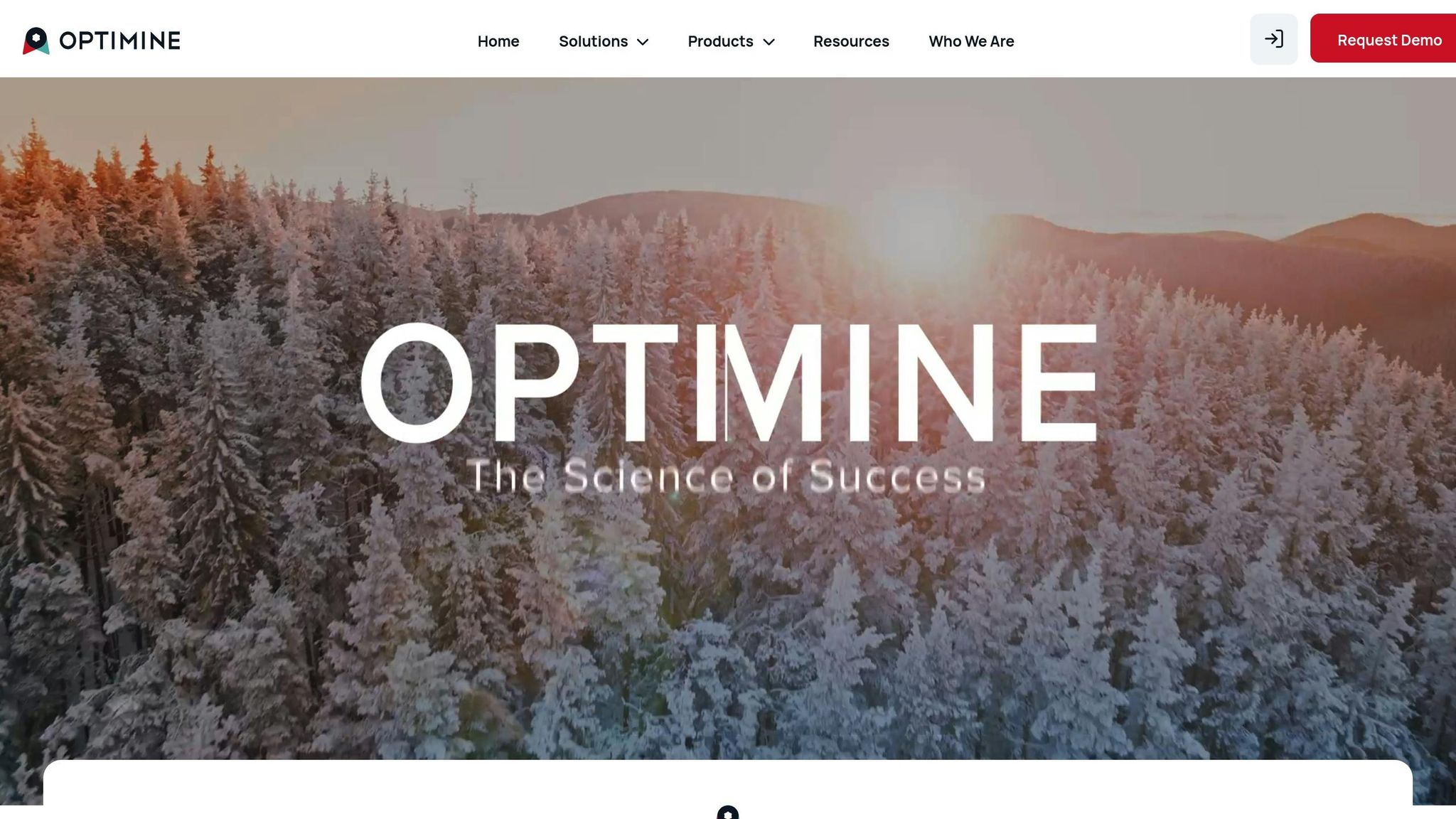Algorithmic attribution helps e-commerce businesses understand how each marketing touchpoint impacts sales, using machine learning to analyze customer journeys. It’s more precise than traditional models like first- or last-click attribution, offering better insights for optimizing budgets and improving ROI.
Key Takeaways:
- What It Does: Distributes credit across all touchpoints (ads, emails, social media) based on their actual influence on conversions.
- Why It's Important: Helps allocate marketing budgets effectively, leading to 15–30% better marketing efficiency.
- Who Needs It: E-commerce businesses navigating complex customer journeys with multiple interactions.
Best Tools for Algorithmic Attribution:
- HubSpot Marketing Hub: All-in-one solution with multi-touch attribution. Starts at $45/month.
- Dreamdata: Tailored for long sales cycles, integrates with CRMs. Pricing upon request.
- Triple Whale: Focused on e-commerce, offers real-time insights and automation. Plans from $279/month.
- Growify: Scalable, simple attribution for growing brands. Starts at $299/month.
- OptiMine: Enterprise-level tool with precise modeling and testing. Custom pricing.
Quick Comparison:
| Tool | Starting Price | Best For | Key Features |
|---|---|---|---|
| HubSpot | $45/month | All-in-one marketing | CRM integration, multi-touch modeling |
| Dreamdata | Custom | Long sales cycles (B2B) | Machine learning for extended journeys |
| Triple Whale | $279/month | E-commerce brands | Real-time insights, automation |
| Growify | $299/month | Growing e-commerce | UTM tracking, scalable pricing |
| OptiMine | Custom | Large enterprises | Incrementality testing, transparency |
How To Pick The Right Attribution Model For Your Ecommerce Business: Tips From A Roller
What Is Algorithmic Attribution in E-commerce?
Algorithmic attribution is a method of analyzing customer journeys using data-driven techniques like statistical analysis and machine learning. Instead of following rigid rules, it assigns credit to each marketing touchpoint based on its real impact on conversions. This approach digs into actual customer behavior to figure out which interactions genuinely drive sales, giving credit to all the touchpoints that play a role in the process.
"Attribution is a measurement technique that collects and analyzes the marketing and organic sources leading to a key event such as a purchase." - Nicolas Grasset, Peel
Unlike last-click attribution, which credits only the final interaction before a purchase, algorithmic attribution takes a broader view. It evaluates all interactions across different channels and touchpoints - like ad clicks, website referrals, and campaign data - and assigns weights based on their timing and influence.
Main Features of Algorithmic Attribution
Algorithmic attribution stands out because it uses advanced machine learning to process massive amounts of customer journey data. It identifies patterns by comparing the paths of customers who make a purchase with those who don’t. These systems go beyond basic tracking by employing sophisticated visitor identification methods, enabling true multi-touch attribution. For example, when cookies aren’t available, techniques like browser fingerprinting help ensure accurate tracking and mapping of customer journeys.
Why E-commerce Businesses Need Algorithmic Attribution
E-commerce marketing is complex, involving multiple channels and touchpoints before a purchase happens. Research shows that 75% of marketers now use multi-channel attribution, and B2B brands typically expose customers to an average of 36 touchpoints before they convert.
The benefits of algorithmic attribution are clear from real-world examples. Select Home Warranty reported a 36% jump in leads and a 20% drop in cost-per-conversion after adopting data-driven attribution. Similarly, Medpex achieved 29% more conversions while cutting cost-per-conversion by 28%. These results demonstrate how crediting multiple touchpoints, rather than just the final one, can lead to smarter budget allocation across the entire customer journey.
The advertising landscape has also changed significantly with updates like iOS 14.5, which allowed users to opt out of tracking. This shift has made older attribution methods less reliable and driven up advertising costs. In this new environment, advanced attribution models have become essential for e-commerce businesses looking to stay competitive.
Main Benefits of Algorithmic Attribution for E-commerce
Algorithmic attribution enhances performance insights and improves ROI by accurately crediting every touchpoint in a customer's journey.
Accurate Conversion Attribution
One major advantage of algorithmic attribution is its ability to paint a clear and detailed picture of how each marketing touchpoint contributes to conversions. Traditional models like first-touch or last-touch attribution often oversimplify the complex web of modern customer interactions, especially in today’s multi-channel, multi-device world.
With algorithmic attribution, credit is distributed dynamically based on the actual influence of each interaction. By analyzing historical data, it calculates the true value of each touchpoint, adjusting for patterns in customer behavior. AI-driven models go a step further, evolving continuously to detect nonlinear interactions across platforms, devices, and behaviors - uncovering patterns that older models tend to overlook. For instance, a 2022 eMarketer report highlighted that 45% of digital marketers identified cross-device tracking as their biggest attribution challenge. This level of precision ensures marketing budgets are allocated more effectively.
Better Marketing Budget Allocation
Accurate attribution insights naturally lead to smarter budget allocation. Businesses that adopt advanced attribution models often experience a 15–30% boost in marketing efficiency. These models help identify which channels are undervalued or overvalued, allowing for better optimization of resources.
Take ASOS as an example: In 2022, the company utilized Google’s data-driven attribution model and discovered that its influencer marketing program was responsible for 23% more conversions than previously credited. This realization led to a strategic expansion of influencer partnerships and a 30% year-over-year increase in new customer acquisition. Beyond identifying valuable channels, algorithmic attribution also highlights opportunities for upselling and cross-selling across customer interactions, ensuring every marketing dollar works harder. By keeping an eye on shifting consumer behaviors, businesses can refine their strategies and reduce spending on ineffective touchpoints.
Flexibility for Customer Journeys
E-commerce customer journeys are anything but straightforward. They often span multiple touchpoints, including ads, emails, organic search, social media, and even offline interactions. Algorithmic attribution thrives in this complexity by adapting to customer behavior in real time, rather than forcing it into rigid, predefined frameworks. Unlike traditional models, which rely on static rules, AI-driven attribution uses machine learning to automatically adjust as customer habits evolve.
This adaptability is key for integrating insights across channels. The system consolidates signals from various platforms, offering a unified view of how different touchpoints influence the customer journey. While conventional models provide basic insights with limited detail, algorithmic attribution delves deeper, offering granular behavioral insights and predictive analytics. It doesn’t just explain what happened - it helps businesses understand why it happened. This comprehensive approach gives e-commerce brands a clearer, more actionable understanding of how customers shop and make decisions.
Important Features to Look for in Algorithmic Attribution Tools
Selecting the right attribution tool can make or break your e-commerce marketing efforts. Data-driven businesses outperform others significantly, acquiring customers 23× faster and being 19× more profitable. With such high stakes, choosing a tool that aligns with your goals is essential.
Building on the advantages of algorithmic attribution, the right tools can help e-commerce marketers optimize every customer interaction. The most effective solutions combine seamless integration, real-time data processing, and intuitive dashboards. These features work together to transform raw data into insights that drive revenue and improve decision-making. Let’s dive into the key features that make these tools indispensable.
Integration with E-commerce and Ad Platforms
To fully understand customer journeys, your attribution tool must integrate effortlessly with platforms you already use. Think Shopify, Amazon Seller Central, Google Ads, Facebook Ads, Klaviyo, or even your CRM and ERP systems. Without this level of integration, you risk missing critical touchpoints, leading to incomplete data and less effective marketing strategies.
Modern customers interact with brands across a variety of channels - paid ads, email, social media, search engines, and affiliate programs. A tool that captures data from all these sources ensures you get the complete picture of how customers find and engage with your brand.
Consider the case of SugarGang, a German direct-to-consumer brand. After Apple's iOS 14 update disrupted their tracking capabilities, they struggled with data attribution. By adopting Admetrics, which uses server-side tracking and UTM parameters, they regained reliable campaign insights. This allowed them to optimize their strategies and ultimately triple their return on ad spend.
Real-time Data Processing
In the fast-moving world of e-commerce, waiting even a few hours for insights can mean missed opportunities. Real-time data processing offers an up-to-the-minute view of your marketing performance, enabling quick and informed decisions.
With real-time insights, you can instantly identify which campaigns are working and adjust your strategy to maximize ROI. If a campaign isn’t performing as expected, immediate changes can prevent wasted budget. Real-time data also supports dynamic pricing strategies, allowing you to react instantly to market trends and competitor pricing to boost revenue.
Real-time processing isn't just about speed; it also helps with anomaly detection. By spotting unusual patterns in user behavior as they occur, you can address issues proactively. For example, Macy’s leveraged real-time data to streamline inventory and order management, freeing up resources for strategic growth. Similarly, American Airlines used real-time data to ensure smooth operations and deliver a better customer experience.
Easy-to-Use Dashboards
Even the most advanced attribution tool is useless if your team can’t interpret the data it provides. That’s why intuitive dashboards are a must. The best tools simplify complex data, making it accessible even to team members without a technical background.
Your dashboard should clearly present key metrics and offer customizable reporting options tailored to your business needs. For instance, a marketing manager might prioritize campaign performance metrics, while a CFO might focus on cost efficiency. A good tool allows both to get the insights they need without requiring extensive training or support.
Look for dashboards that combine visual clarity with actionable insights. They should highlight trends, flag underperforming channels, and suggest areas for improvement. When your team can quickly understand and act on attribution data, you’ll see faster gains in marketing efficiency and overall business performance.
sbb-itb-5174ba0
Best Tools for Algorithmic Attribution in E-commerce
Here’s a look at some of the top tools for e-commerce attribution. These platforms stand out for their seamless integrations, real-time capabilities, and intuitive dashboards, catering to businesses of various sizes and needs.
HubSpot Marketing Hub

HubSpot combines marketing automation with powerful attribution features, seamlessly integrating CRM, email marketing, and automation tools. Its attribution reporting tracks the entire customer journey - from the first interaction to conversion - making it a go-to option for businesses seeking an all-in-one marketing solution.
The platform’s multi-touch attribution modeling helps you understand how different channels - like email campaigns, social media, paid ads, and organic search - work together to drive results. Using machine learning, HubSpot assigns credit to touchpoints based on their actual impact.
It integrates with Shopify, WooCommerce, Google Ads, Facebook Ads, and LinkedIn, offering customizable reporting to fit your specific needs.
- Pricing: Starts at $45/month for the Starter plan with basic reporting, $800/month for the Professional plan with advanced features, and $3,200/month for Enterprise plans offering full attribution capabilities.
Dreamdata

Dreamdata is tailored for businesses with longer sales cycles, using machine learning to allocate revenue across extended customer journeys. It’s particularly useful for companies selling high-value products, where buyers often take weeks or months to finalize decisions.
The platform connects to your website, CRM, and ad accounts, simplifying data collection and modeling. It tracks anonymous visitors across sessions and devices, linking them to eventual purchases.
Dreamdata integrates with Salesforce, HubSpot, Google Analytics, and other major platforms, and it also offers API access for custom setups.
- Pricing: Ranges from $500 to $2,000/month for small to medium businesses, with pricing available upon request.
Triple Whale

Designed specifically for e-commerce brands, Triple Whale provides comprehensive tracking across all marketing channels, from paid ads to email and SMS campaigns. It’s ideal for those aiming to optimize ad spend and identify high-performing strategies.
"Operating without reliable attribution is like navigating without a compass. Brands that lean into accurate attribution can cut through the noise of conflicting data sources to identify which marketing efforts drive incremental revenue."
- Ethan Shust, Sr. Product Marketing Manager, Triple Whale
Using AI-powered tools like Moby Agents, Triple Whale automates tasks such as adjusting ad spend and reallocating budgets based on real-time performance. It also addresses post-iOS 14 challenges with server-side tracking and first-party data.
- Pricing: The free "Founders Dash" plan offers basic tracking. Pro plans cost $279/month, while the Growth plan is $1,290/month, with support for unlimited users and multi-store integration.
Growify
Growify is perfect for growing e-commerce businesses, offering straightforward attribution tools that don’t require a dedicated data science team. It uses UTM parameters and first-party data to track customer journeys across multiple touchpoints.
The platform integrates with Meta, Google, TikTok, and Klaviyo, covering essential acquisition and retention channels. Its transparent pricing - based on monthly website visitors - ensures predictable costs as your business expands. Real-time modeling and customizable lookback windows highlight which channels drive awareness and conversions.
- Pricing:
- Starter: $299/month for up to 10,000 visitors
- Scale: $499/month for up to 50,000 visitors
- Pro: $799/month for up to 100,000 visitors
- Enterprise: Custom pricing for businesses exceeding 100,000 visitors.
OptiMine

OptiMine is all about transparency and precision. It uses statistical modeling to provide clear insights into how attribution decisions are made, giving marketing teams confidence in their data. The platform also specializes in incrementality testing, helping businesses identify which channels drive additional sales beyond baseline growth.
OptiMine’s models account for factors like seasonality, competition, and market trends, making it easier to separate organic growth from marketing-driven results. While it integrates with major advertising and e-commerce platforms, the setup process is more technical, making it best suited for businesses with dedicated analytics teams.
- Pricing: Custom quotes available upon request. OptiMine does not offer free trials, positioning itself as an enterprise-level solution.
Tool Comparison: Features and Pricing
Choosing the right tool for your business depends on factors like company size, budget, and specific needs. Below is a comparison of five platforms, highlighting their main features, pricing details, and potential drawbacks.
| Tool | Starting Price | Best For | Key Strengths | Main Limitations |
|---|---|---|---|---|
| HubSpot Marketing Hub | Starting at $20/month for basic plans | All-in-one marketing solutions | Wide range of integrations, easy-to-use interface, and robust CRM capabilities | Advanced attribution features only available in higher-tier plans |
| Dreamdata | Contact vendor for pricing | B2B businesses with long sales cycles | Uses machine learning to map customer journeys and consolidate go-to-market data | Pricing is not publicly available; limited third-party integrations |
| Triple Whale | Contact vendor for pricing | E-commerce businesses | Provides automated attribution insights and real-time recommendations | Advanced features may require complex setups and premium plans |
| Growify | Contact vendor for pricing | Growing e-commerce brands | Scalable tools with real-time modeling for traffic growth | Entry-level plans may restrict data capacity |
| OptiMine | Custom pricing | Large enterprises | Offers clear attribution modeling, incrementality testing, and statistical transparency | Requires technical expertise and is geared toward large-scale operations |
The table provides an overview of the tools, while the sections below take a closer look at their pricing models, feature depth, and technical requirements.
Pricing Structure Analysis
Pricing varies significantly across these tools. HubSpot stands out with its entry-level plans starting at $20/month, making it accessible for smaller businesses. However, its advanced attribution capabilities come with higher-tier packages. Dreamdata, Triple Whale, and Growify offer custom pricing, requiring businesses to consult directly with vendors. This approach caters to companies with specific needs or growing attribution complexities. OptiMine, designed for enterprise-level operations, also uses a custom pricing model, reflecting its focus on high-budget, large-scale marketing strategies.
These differences in pricing reflect the tools' varying levels of customization and complexity, which can impact how businesses plan their marketing budgets.
Feature Depth and Technical Requirements
Each platform strikes a balance between usability and technical sophistication. HubSpot is known for its intuitive design, featuring multi-touch attribution models powered by machine learning. Triple Whale addresses e-commerce challenges with automated insights based on real-time performance data. OptiMine, on the other hand, prioritizes precision with features like incrementality testing, helping businesses distinguish between organic growth and marketing-driven results.
The technical expertise required also varies. User-friendly platforms like HubSpot and Triple Whale cater to marketing teams without advanced analytics knowledge, offering straightforward dashboards and automation. In contrast, tools like OptiMine demand a higher level of technical skill, making them better suited for organizations with dedicated analytics teams or external support.
Value Proposition by Business Stage
For startups and small businesses, tools with simple attribution features and affordable pricing - like HubSpot - are a practical choice. As e-commerce brands expand, platforms that combine advanced functionality with ease of use, such as Triple Whale or Growify, become essential for scaling operations efficiently. Enterprise-level businesses with complex marketing needs may find OptiMine’s focus on precision and tailored support ideal for optimizing multi-touchpoint customer journeys and refining budget allocation strategies.
Conclusion
Picking the right algorithmic attribution tool can make a huge difference in e-commerce success. Studies have shown that data-driven attribution models can increase conversions and cut customer acquisition costs. For instance, companies like ASOS and Warby Parker have seen impressive results using these tools, with marketing efficiency improving by 15–30%. These figures highlight how critical it is to choose a tool that fits your needs.
Whether you’re a startup looking for accessible options or a more established brand seeking advanced solutions, there’s a tool for every stage of growth. As privacy regulations change and third-party cookies phase out, these tools become even more valuable. They allow businesses to adjust quickly to evolving customer behavior and make real-time optimizations.
Investing in algorithmic attribution means smarter budget decisions, better ROI, and a deeper understanding of your customers. Whether you’re starting small with multi-touch attribution or diving into machine learning-powered systems, the tools mentioned here can set the stage for data-driven growth in today’s complex e-commerce world.
For more in-depth analytics solutions, check out the Marketing Analytics Tools Directory at https://topanalyticstools.com. It’s a great resource to compare tools and refine your attribution strategy.
FAQs
How does algorithmic attribution help optimize marketing budgets compared to traditional models?
Algorithmic attribution gives marketers a clearer picture of where their budget is best spent by analyzing which channels and touchpoints contribute the most to conversions. Unlike traditional models - such as first-touch or last-touch attribution, which follow rigid rules - this method leverages machine learning to study customer journeys and identify the interactions that hold the most value.
By using this approach, businesses can allocate their resources more strategically, directing marketing dollars toward efforts that truly drive results. The outcome? Higher ROI, more informed decisions, and stronger campaign performance overall.
What should e-commerce businesses consider when selecting an algorithmic attribution tool?
When selecting an algorithmic attribution tool for your e-commerce business, it's important to focus on a few critical factors to ensure the tool aligns with your needs:
- Data accuracy and integration: The tool should work effortlessly with your current platforms and deliver precise, real-time analytics you can trust.
- Customizable attribution models: Opt for tools that let you adapt models to fit your specific marketing strategies and customer journey.
- Ease of use: A straightforward, intuitive interface makes it easier to interpret insights and act on data quickly.
- Customer support: Responsive, reliable support can make implementation smoother and save valuable time.
Also, keep your business goals in mind - whether you're analyzing channel performance or refining specific stages of the customer journey. Choose a tool that directly supports these objectives.
How can e-commerce businesses adapt to privacy changes like iOS 14.5 while ensuring accurate data tracking with algorithmic attribution tools?
E-commerce businesses can adapt to privacy updates like iOS 14.5 by shifting to privacy-conscious tracking methods that focus on aggregated and anonymized data. This approach reduces dependence on tracking individual users while still providing meaningful insights for attribution models.
Another smart move is implementing server-side tracking. Unlike client-side cookies, this method collects data directly from servers, offering a more stable and reliable way to handle privacy changes. By adopting these strategies, businesses can maintain accurate data for attribution, respect user privacy preferences, and stay aligned with changing regulations.


